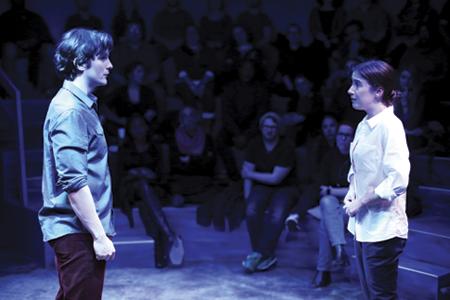Love Is a Many-Outcomed Thing at Studio Theatre
By • March 18, 2016 0 832

You have to make your way — take an elevator, walk — and be willing to think about quantum physics and string theory (and a little bit about how honey is made) to get to, and get, “Constellations,” the play by Nick Payne at Studio Theatre through March 27. But in the end — and in the beginning, too — it’s well worth the effort.
Directed by David Muse, “Constellations” is a two-character romance that also happens to bring in the universe, and the prospect of multiple universes, which is apparently the favorite topic of quantum physicists and string theorists. Boy meets girl, or girl meets boy, girl asks boy if he can lick his elbow and what that might entail. Boy says, “I’m married.” Blackout.
If that was all there was to it, it would be a very short play indeed, shorter than the relatively brief length that “Constellations” is: a little over an hour with no intermission. But playwright Payne asks us to entertain the notion that that brief encounter is just one thing that could happen, that actually there are countless ways things work out — decisions and replies and choices that would result in a different world and outcome altogether.
In other words, after several different back-and-forths, the couple — a high-hopes, energetic physicist named Marianne and a quieter, hesitant beekeeper named Roland — do get together and embark on a life together (and apart); they break up (or not); they re-connect (or not); and face life’s tragedies, including a big one at the end. All along the way, they choose: yes, no, maybe, let’s do this but not that, let’s define love this way and that way, let’s stay together, let’s move on. They do things (or don’t), they betray each other (or not), they sleep together right away (or much later).
This could get cute — like a blueprint for a Tom Hanks-Meg Ryan movie with study notes — but most of the time the play avoids the pitfalls of goo. It perhaps does not avoid an equally alarming danger, of being sometimes a little too enamored of just how clever and intelligent the concept is. But what the play demands most of all from the audience isn’t so much awe and admiration as engagement.
The artists certainly have worked hard to create a kind of welcome mat for the audience. It’s ultra-theater in the round, a circular wall (like a beehive?) with an entrance where you can, if you want, pick up a pillow to sit in a spot not conducive to lying back in comfort. Overhead, the space is lit by fluorescent tubes that change colors as the two actors — Lily Balatincz as Marianne and Tom Patterson as Roland — live out the characters without props. The dialogue is witty, often a verbal ping-pong match, but it’s not difficult to keep track of things once the concept reveals itself on stage.
Balatincz and Patterson have a tricky task here. They have to be verbally sharp, changing the emphasis in a word here and there. Mostly, though, it’s their heartbeats that keep the concept alive. The characters don’t appear to be movie creations. They seem to have a place in reality, real lives which sound to be somewhat tony English, what with the broad accents. Balatincz gives Marianne a smart self-assurance, but also a feathery kind of imbalance and uncertainty about herself, as if she’s not quite sure where her next breath or word might take her. Patterson has a grungy, skinny, bewildered quality that makes Roland a frustrating, sometimes annoying, but also appealing man-boy-child.
These two are charmers in audience terms; they’re not dazzlers, they’re something better: attractive and funny. Concept aside, a lot of what’s really going on here is as simple and complicated as the difference between the sexes, something no amount of scientific theory seems to know how to manage. What happens in this small, very intimate space is something that obviously resonates with the audience.
It’s interesting to watch the watchers here — mostly because you can’t avoid it. Some couples, especially in the front row, closest to the action, settle in (a few close together, touching or holding hands). This seems to change over the course of the play as each character betrays the other, wounding verbally or otherwise. The hands disengage, a tiny distance appears between the twosomes in the audience that disappears again toward the end, and in the aftermath, when there’s a lot of talk about theory and love.
Director David Muse moves things along briskly, with a deep affection for the characters. Set and lighting designers Debra Booth and Michael Lincoln, respectively, have given the audience a very special place that can contain so many possibilities and outcomes with ease.

